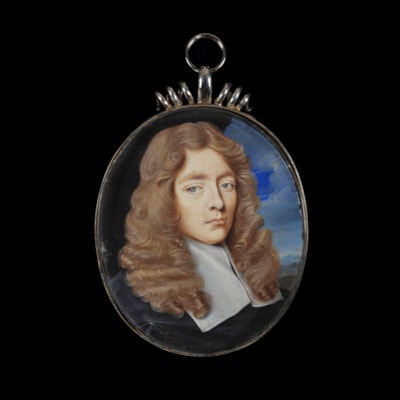DAVID DES GRANGES
(c.1611-c.1672)Portrait miniature of King Charles II (1630-1685), wearing a decorated doublet under an armour breastplate and the blue sash of the Order of the Garter
Circa 1651
Oval, 5.1 cm (2 inches) high
Watercolour on vellum
SOLD
During Charles’ exile, many portrait miniatures were painted of the King to distribute amongst his supporters, not only as tokens of affection, but to deliberately ensure that the likeness of the King kept circulating prominently to garner and encourage supporters. Given the size of portrait miniatures, they could be secretly given and kept, with their protective features enhanced by their encasement in lockets and closed-cases. Des Granges produced many miniatures of Charles II, often copied from full-scale portraits of the King including by Adriaen Hanneman and Philippe de Champaigne (whose portrait may have provided inspiration for Des Granges to include the tassels on Charles’ collar in the above portrait), to encourage continued loyalty to the monarchy, but also to provide much-needed fiscal security for the royal family. The importance of portrait miniatures extended into the process of restoring the crown after Oliver Cromwell’s death in 1660.
Des Granges painted numerous ‘types’ of miniatures of the King, which are listed by Gibson in her thesis on the iconography of Charles. The present miniature falls into his ‘own’ type, another example of which can be found at the Ashmolean Museum in Oxford[1]. In her thesis on the iconography of the King, Gibson lists ten versions of this miniature, including this particular example. They all feature a ‘wispy moustache’, ‘single straggling lock on one temple’[2], and the distinctive tassels that hang from his collar. It has a rather interesting provenance, given that in the past it was believed to be a portrait of Sir Charles Lucas (1613-1648), by Richard Gibson (1615-1690). When it was exhibited in Brussels in 1912, the miniature was given this identification. The first re-attribution to des Granges appears to have been in 1916, when the miniature was listed as a version of another portrait by the artist in the Portland Collection at Welbeck Abbey[3]. Since then, it has gone through the collection of Arbury Hall, Warwickshire, before appearing on the European art market. Now, the attribution to des Granges can be made with confidence, given the handling of the portrait and similarity to other miniatures painted by the artist of this type.
[1] David Des Granges (1611-1672), Portrait of Charles II; 1650, Watercolour on vellum, 7.2 x 5.9 cm, signed and dated D.G. 1650 (Western Art, Ashmolean Museum, Oxford).
[2] K. Gibson, “Best belov’d of Kings”: The Iconography of King Charles II, Courtauld Institute of Art, University of London, 1997, p. 292, no. 271.
[3] R. W. Goulding, ‘The Welbeck Abbey Miniatures belonging to His Grace, the Duke of Portland: a catalogue raisonnée’, Walpole Society, 4 (1916), p.101, under no. 89, ‘e’.
Fitzroy Newdegate Collection, Arbury Hall, Nuneaton, Warwickshire (by 1997);
Private collection, Europe.
R. W. Goulding, ‘The Welbeck Abbey Miniatures belonging to His Grace, the Duke of Portland: a catalogue raisonnée’, Walpole Society, vol. 4, 1916, p.101, under no. 89, ‘e’.
K. Gibson, “Best belov’d of Kings”: The Iconography of King Charles II, Courtauld Institute of Art, University of London, 1997, vol. 2, p. 292, no. 271.

shipping notice
Worldwide shipping is included in all prices.
The Limner Company does not accept any responsibility for import duty, this is to be paid by the buyer.
Some stock items contain materials from endangered species which are governed by CITES regulations and will require a permit to export outside of Great Britain. If a certificate of export is required then this will be the responsibility of and paid for by the buyer .
you may also like













